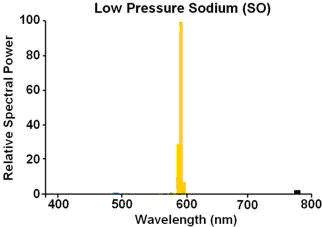Emission Lines Resource Page
Use 600 lines/mm grating from Peter to record the region around the Oxygen
line during re-entry. This is at 777nm. The formula for the angular offset A
between zeroth and first-order spectrum at wavelength W
is below. On-line
grating angle calculator is here. 110nm FOV on PC164C chip width,
est by PJ at SETI. 25.6 nm per degree on the sky
A = sin-1(600mm-1 x W(mm)).
A = sin-1(600 x 777.4x10-6) = 27.80 degrees for 777nm Oxygen, and 28.30
deg for 790nm optimum for getting both O I's and both N I triplets
A = 20.70 deg for Sodium D at 589nm
A = 23.2 deg for H-alpha at 656nm
For practice, consider using Mercury Vapor street lights or Low or High Pressure
Sodium street lights...

LP Sodium, essentially a single line at
589.0nm of the Sodium D doublet
|

Visual of spectrum of HP sodium lamp. The
sharp line at the green/yellow boundary is the 589 nm Sodium D line,
broadened by high pressure
|

Leonid spectrum
in near IR, with my setup's FOV indicated. Wavelengths of O I 845nm, middle
of N I triplet at 825nm, O I at 777nm, and middle of N Itriplet at 745nm
indicated. (from Jenniskens
etal 2004) |

Spectrum of HP Sodium street
lamp |
Star pairs at relevant angular offsets are below. Note that these pairs will
be at different position angle on the sky and therefore will give different
orientation to the direction of dispersion. You want the direction of dispersion
to ideally be perpendicular to the vector between capsule and spacecraft.
Java
Applet for Angle Between Two Stars (note 25.6 nm per degree on the sky,
and 110 nm = width of FOV). On-line
grating angle calculator
Oxygen I (777nm) Star Pairs
Antares: RA=16.49h Dec=-26.432 and Eta Centauri: RA=14.591666h Dec=-42.15777
gives sep=28.08deg
Sigma Sco: RA=16.353h Dec=-25.592777
and Eps Sagittarii RA=18.403h Dec=-34.38466
gives sep=27.92deg
Spica: RA=13.42h Dec=-11.161388 and Beta Librae:
RA=15.28333 Dec=-9.38305 gives sep=27.55deg
Alpha Ser V=2.7 K2 RA=15.73777h
Dec=6.425555 and delta Boo V=3.5 RA=15.258333 Dec=33.314722 gives sep=27.705deg
Alpha Ser V=2.7 K2 RA=15.73777h Dec=6.425555 and Omega1
Sco V=4 RA=16.113333h Dec=-20.6691666 gives sep=27.654deg
Alpha Ser V=2.7 K2 RA=15.73777h Dec=6.425555 and Alpha Oph RA=17.58222 Dec=12.56000
gives sep=27.95deg
Denebola V=2.2 A3 RA=11.817766 Dec=14.5719444 and Cor Caroli V=2.8 RA=12.933888
Dec=38.318333 gives sep=27.975deg
Saturn V=1.2 RA=11.94 Dec=2.9835 and Beta (foot) Corvus (V=2.7
G5) RA=12.57305 Dec=-23.39666 gives sep=27.96deg and Perp to Path
Arcturus V=0.2 RA=14.261111 Dec=19.1825 and Mu Vir V=3.9 F2 RA=14.717777
Dec=-5.658333 gives sep=25.74. Need 2.56 deg more. That's 9.3% more distance
than the distance and dir from 109 Vir to Mu Vir
Sodium D lines at 589nm Angle=20.7 deg radius, 41.4deg diameter
for C2A
Denebola V=2.2 A3 RA=11.817766 Dec=14.5719444 and Gamma Vir (Porrima) V=2.8
RA=12.6944433 Dec=-01.449444 gives sep=20.644deg
Alpha Ser V=2.7 K2 RA=15.73777h Dec=6.425555 and Alpha CorBor RA=15.57805 Dec=26.714722
gives sep=20.417 deg
H-Alpha line at 656nm, angle=23.2 deg radius or 46.4 deg diameter
for C2A
Spica RA=13.42 Dec=-11.1613888 and Epsilon Virginis (her hand) V=3 RA=13.0363888
Dec=10.9591666 gives sep=22.85 deg
delta Oph V=3 RA=16.239166 Dec=-03.694444
and gamma Herculis V=3.7 RA=16.3652777
Dec=19.1530555 gives sep=22.92 deg
theta Leonis V=3.3 RA=11.237222
Dec=15.42944 and Omicron Leonis V=3.7
RA=9.685833 Dec=9.89222 gives sep= 23.353deg
Early Eve for proper 180 orientation of grating: recording cam at Procyon and
tracking cam on Venus. Must get both angle diff and grating rotation on same
pair, so essential that at least one of our stars be bright enough to produce
a spectrum.



